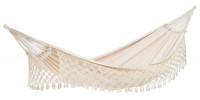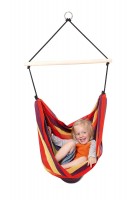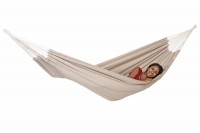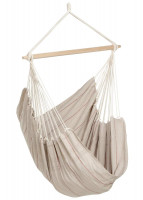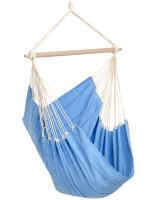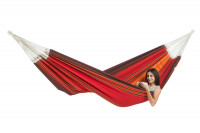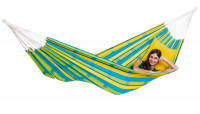Therapeutic hammocks and therapeutic swings can support people in various therapies - for example, autism spectrum disorders especially in children.
Our society is in many areas not yet adapted to the needs of non-neurotypical people, so their everyday life is often difficult. We are even more pleased to be able to offer a small assistance with our hammocks that can help to make everyday life more relaxed.
Needs of autistic children are versatile and individual. After a survey in which autistic children were allowed to test our hammocks in their everyday life, we have evaluated the results and are happy that the hammocks offer so many advantages to the kids.
50% of kids used the hammock at least 4 times a week, and more than 35% used it more than 10 times.
Swingin in a (therapeutic) hammock for more relaxation in everyday life
The rocking of the (therapeutic) hammock can have a calming effect on the brain and thus provide relaxation in stressful situations. Possibly even de-escalate these situations. 80% of parents have used the hammock as a support for the kids in such situations.
- "He was able to calm down faster and felt deeper."
- "He hits his head less and goes into the hammock more often when there is sensory overload and holds it closed over him."
- "It's always depended on the situation. If we noticed early enough that she was having some stress, we've been able to calm her down well with the rocking. At home (just now on the nice days we put the hammock outside) the mouse would put herself in the hammock. There were days when she was busy for 20 to 30 minutes just lying, swinging and herself. After that, she seemed more balanced."
In over 90%, the hammock was used to calm down in stressful situations/play, this was especially the case after physical exertion, after eating and after playing.
Similar things have also been seen in babies in general.
Therapy swing for easier falling asleep
Children with hyper-reactivity often have trouble calming down before bedtime. Light rocking in the hammock and the feeling of being "held" can improve falling asleep.
- >50% of parents report that their child falls asleep easier since they have a hammock
Hammock as a place of retreat for children
A hammock offers a quiet retreat when overloaded with stimuli. With a large hammock you can also fold the fabric over you and then really lie in his own little cave so the hammock is also a good place to just be for himself.
-
"The hammock serves as a retreat during stress, a place to hide, because in our house it hangs down from the ceiling like a kangaroo pouch."
-
"...] he's really set up the hammock as a retreat, with a pillow and blanket, and he swings part of the time monotonously and obliviously. The best way for him to get rest."
Hammock swings promotes sense of balance and coordination in children
Rocking in the hammock stimulates the vestibular system in the ear, which is responsible for sense of balance, coordination and orientation.
-
"My child completely rejected swinging on a normal (playground) swing before. Since he regularly uses the hammock he has discovered his love for swinging and also uses every swing on playgrounds"
"My little one has become an acrobat because of the hammock chair".
The hammock as a space for physical contact
Social interaction with others is often difficult for children from the autism spectrum. The following statements from parents when testing our hammocks are all the more gratifying:
-
"The hammock has fully triggered the boom with our other two children, so that we had to introduce fixed hammock times in part ;o). However, all three also laid in there together, sometimes to crawl, sometimes to cuddle. He could tolerate body contact well in the confines. Overall, the feeling of being wrapped up, like in a cocoon, was very comfortable for him. Thank you so much for letting us test! The hammock was super received here and definitely a win :o)"
-
"Yes, thanks to the hammock my two sons have also become much closer. They usually sit in it together and talk or tickle each other. Before, I could barely get them to sit next to each other or touch each other."
Therapeutic hammock to promote creativity in children
-
"My son has christened his hammock "boat" and when he needs his rest and lies in it, we are not allowed in his room because baby sharks swim around his boat. He didn't show that kind of creative thinking at all until now."
-
".... great interaction game: taking turns with sister, rocking the doll. She also wanted to swing "wildly" with the hammock rather than lie quietly in it. I could imagine that this wild rocking also has exactly the stress-reducing effect. But I could also well imagine that the hammock could become interesting as a retreat in some time."
More about the topic of hammocks in the autism spectrum
Have you ever slept in a hammock? => 5 reasons why you should definitely give it a try


